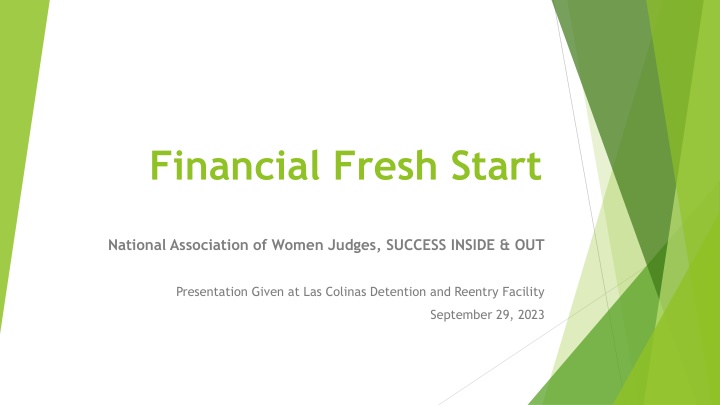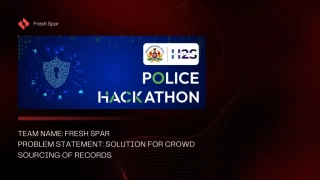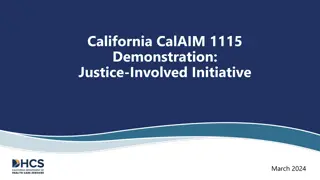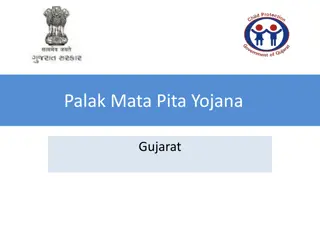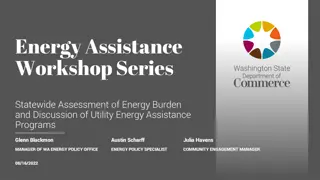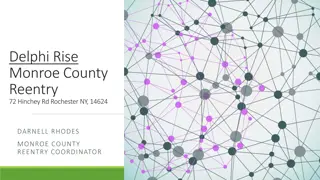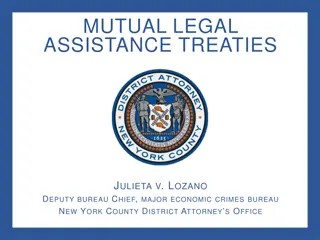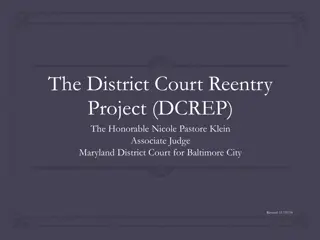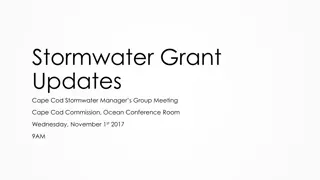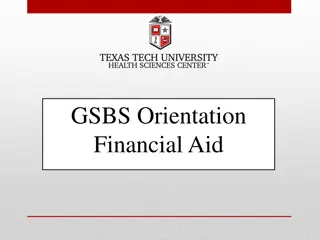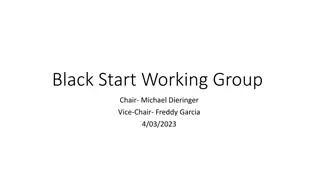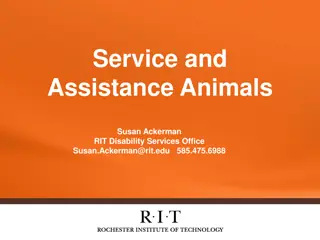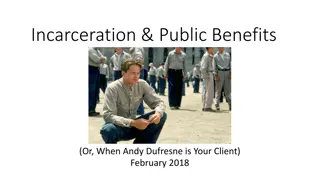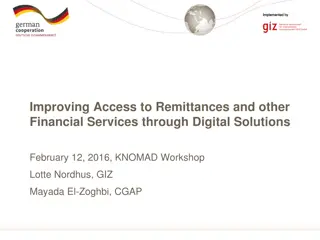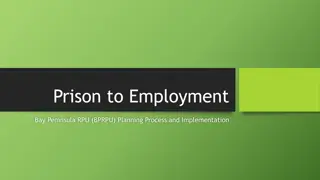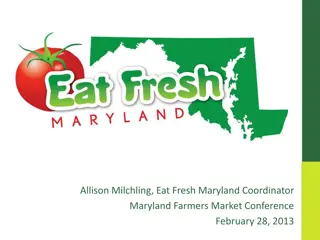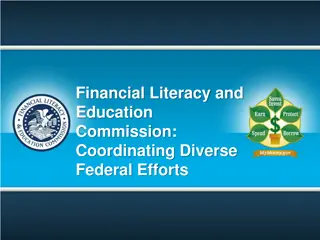Financial Fresh Start Assistance for Reentry into Society
Explore resources and programs like TANF, Second Chance, and CalWORKs that offer assistance for housing, employment, counseling, and more to support individuals starting afresh after release from detention. These initiatives aim to provide financial subsidies, job readiness training, and essential services to help individuals meet their needs and transition successfully into society.
Download Presentation

Please find below an Image/Link to download the presentation.
The content on the website is provided AS IS for your information and personal use only. It may not be sold, licensed, or shared on other websites without obtaining consent from the author.If you encounter any issues during the download, it is possible that the publisher has removed the file from their server.
You are allowed to download the files provided on this website for personal or commercial use, subject to the condition that they are used lawfully. All files are the property of their respective owners.
The content on the website is provided AS IS for your information and personal use only. It may not be sold, licensed, or shared on other websites without obtaining consent from the author.
E N D
Presentation Transcript
Financial Fresh Start National Association of Women Judges, SUCCESS INSIDE & OUT Presentation Given at Las Colinas Detention and Reentry Facility September 29, 2023
STARTING FRESH AFTER YOUR RELEASE and MEETING YOUR NEEDS
What are your needs? Freedom to Progress: Higher Purpose Freedom to Grow: Self- Improvement & Achievement Self-fulfillment Self-esteem, Education Freedom to Thrive: Love & Belonging Family, Acceptance, Understanding Freedom from Fear: Feeling Safe & Secure Physical & Emotional Safety Shelter, Food, Clothing Freedom from Want: Survival
Freedom to Progress: Higher Purpose Freedom to Grow: Self- Improvement & Achievement Freedom from Want Freedom to Thrive: Love & Belonging Freedom from Fear: Feeling Safe & Secure Freedom from Want: Survival You want to start over. You need somewhere to live, to work. You need counseling, but have limited resources. The first step is to get on your feet and survive.
Freedom to Progress: Higher Purpose Freedom to Grow: Self- Improvement & Achievement Freedom from Want: Financial Subsidies and Assistance Freedom to Thrive: Love & Belonging Freedom from Fear: Feeling Safe & Secure Temporary Assistance for Needy Families (TANF) provides temporary assistance to help pay for food, shelter, utilities, and non-medical expenses for qualifying families: https://www.acf.hhs.gov/ofa/programs/tanf Freedom from Want: Survival Second Chance is a San Diego local non-profit organization that provides assistance to people with addiction, incarceration, homelessness, a family history of criminal behavior or gang involvement: https://www.secondchanceprogram.org/ In addition to the Job Readiness Training program, Second Chance has support services (CDL, Birth certificates, work clothes, tools, transportation and much more) money available to help the participants on their journey to self-sufficiency) and hygiene kits. California Work Opportunity and Responsibility to Kids (CalWORKs) is a public assistance program that provides cash aid and services to eligible families that have a child(ren) in the home. If a family has little or no cash and needs housing, food, utilities, clothing or medical care, they may be eligible to receive immediate short-term help. Families that apply and qualify for ongoing assistance receive money each month to help pay for housing, food and other necessary expenses: http://www.cdss.ca.gov/CalWORKS
Freedom to Progress: Higher Purpose Freedom to Grow: Self- Improvement & Achievement Freedom from Want: Financial Subsidies and Assistance General Relief Freedom to Thrive: Love & Belonging Freedom from Fear: Feeling Safe & Secure Freedom from Want: Survival Temporary cash assistance Maximum monthly grant is $370 Eligibility: Have been a San Diego County resident for at least 15 days Intend to reside in San Diego County Valid ID Income less than $337 (for a single person) or $460 (for a married couple) Very limited resources (a vehicle of up to $4,650 in value is exempt) Repaid to County requirements Apply in person at County offices listed below or online at Benefits Cal: https://www.sandiegocounty.gov/content/sdc/hhsa/programs/ssp/general_relief/how_to_appl y.html https://benefitscal.com/
Facilities where this Service is offered: Family Resource Center - El Cajon Family Resource Center - Metro Family Resource Center - North Coastal Family Resource Center - North Inland Family Resource Center - Chula Vista Family Resource Center - Centre City For more information call 1-866-262-9881.
Freedom to Progress: Higher Purpose Freedom from Want: Food Subsidies Freedom to Grow: Self- Improvement & Achievement Freedom to Thrive: Love & Belonging Supplemental Nutrition Assistance Program (SNAP/CalFresh) (aka food stamps ) offers nutrition assistance to millions of eligible, low-income individuals and families and provides economic benefits to communities: https://www.sandiegocounty.gov/content/sdc/hhsa/ programs/ssp/food_stamps.html. This program is accessed by using an Electronic Benefit Transfer (EBT) card. Effective Summer 2019, SSI recipients are no longer banned from receiving SNAP/CalFresh. Freedom from Fear: Feeling Safe & Secure Freedom from Want: Survival The Emergency Food Assistance Program (TEFAP) is a Federal program that helps supplement the diets of low-income Americans, including elderly people, by providing them with emergency food and nutrition assistance at no cost: https://www.fns.usda.gov/tefap/emergency-food- assistance-program-tefap The Special Supplemental Nutrition Program for Women, Infants, and Children (WIC) provides Federal grants to States for supplemental foods, health care referrals, and nutrition education for low-income pregnant, breastfeeding, and non-breastfeeding postpartum women, and to infants and children up to age five who are found to be at nutritional risk: https://www.fns.usda.gov/wic/women-infants-and-children-wic San Diego Food Bank is the largest hunger-relief organization in San Diego County providing nutritious food to individuals and families in need in communities throughout the area: https://sandiegofoodbank.org/
Freedom to Progress: Higher Purpose Freedom from Want: Housing Freedom to Grow: Self- Improvement & Achievement 211 San Diego Reentry Services provides a resource guide with a list of housing options available for individuals released from a local jail or state prison: http://211sandiego.org/resources/highlighted- resources/post-incarceration/ Sober Living Housing Freedom to Thrive: Love & Belonging Freedom from Fear: Feeling Safe & Secure Freedom from Want: Survival For those with MSO (Most Serious Offense), probation will most likely pay for three months of sober living and help with a bus pass when they can. Second Chance Housing program provides quality and supportive sober living housing: https://www.secondchanceprogram.org/housing/ Ex-Offender Halfway Houses: http://sandiego.networkofcare.org/mh/services/subcategory.aspx?tax=FF-1850 Transitional Housing Program (THP) is a voluntary program that provides residency and support services to parolees to enable successful reintegration into their communities. The program offers services that focus on Long Term Offenders (LTOs) needs such as employment, job search and placement training, stress management, victim awareness, computer supported literacy, and life skills. Substance Abuse education and a 52-week certified domestic violence program is provided to applicable parolees. Visit https://www.cdcr.ca.gov/rehabilitation/thp/ East County Transitional Living Center may be an option: https://www.ectlc.org/
Freedom to Progress: Higher Purpose Freedom from Want: Housing Assistance Programs Freedom to Grow: Self- Improvement & Achievement Freedom to Thrive: Love & Belonging Freedom from Fear: Feeling Safe & Secure Types of Housing Assistance Housing Choice Voucher Program contribute % of income as rent Low Income Housing Tax Credit properties pay a set amount in rent Other types, including for elderly, persons with HIV/AIDS, etc. When Applying for Housing Assistance: Important to maintain position on waitlists (change of address, etc.) Eligibility requirements exist, but must be in writing and available (request a copy) Criminal history rules apply, keep in mind: Freedom from Want: Survival Length of time since conviction may be considered Certain convictions serve as a bar If denied because of criminal conviction, seek legal assistance to see if there is basis to appeal (mistakes happen and records may not be accurate) Apply online or in person at Public Housing Authorities San Diego Housing Commission (SDHC) Housing Authority of the County of San Diego (HACSD) Other cities in region also have housing authorities
Freedom to Progress: Higher Purpose Freedom from Want: Employment Freedom to Grow: Self- Improvement & Achievement The Department of Labor: Employment and Training Administration has several grant programs for felons that are pre- release as well as for ex-felons that are out of prison. Most grants are also open to anyone who applies whether they are a felon or not. Visit https://www.grants.gov/web/grants/home.html to apply. Freedom to Thrive: Love & Belonging Freedom from Fear: Feeling Safe & Secure Freedom from Want: Survival As a part of the effort to reduce recidivism and break the cycle of crime to make American communities safer, the U.S. Department of Labor recently announced an $82.5 million investment to help Americans exit incarceration and integrate into the workforce. . The investment will support programs that offer a range of services based on current evidence and proven research, as well as promising emerging practices. Career OneStop is a source for employment information and inspiration, the place to manage your career, the pathway to career success, tools to help job seekers. It has a specific section for ex-offenders that provides state resources and helpful information about hiring and approaches to job seeking with a conviction on the record. Visit https://www.careeronestop.org/ExOffender/default.aspx. SDWP Job Centers offer comprehensive job search services and access to: workshops, hiring events, training programs and other resources: https://workforce.org/careercenters
Freedom to Progress: Higher Purpose Freedom from Want: While you are Searching for a Job Freedom to Grow: Self- Improvement & Achievement Freedom to Thrive: Love & Belonging Freedom from Fear: Feeling Safe & Secure Second Chance offers a Job Readiness Program https://www.secondchanceprogram.org Freedom from Want: Survival You would be ineligible for unemployment benefits when coming out of custody. In San Diego County, you can apply for General Relief: https://www.sandiegocounty.gov/content/sdc/hhsa/programs/ssp/g eneral_relief.html General Relief provides temporary cash assistance for eligible county residents who have no other means of support. Any aid received must be repaid to the county. Completed hours of required Job Training may count toward repayment of the debt.
Freedom to Progress: Higher Purpose Freedom to Grow: Self- Improvement & Achievement Freedom from Want: Healthcare Freedom to Thrive: Love & Belonging General information about benefits for all states is found at https://www.hhs.gov/answers/medicare-and-medicaid/who-is- eligible-for-medicaid/index.html After you re released, you must either have health coverage, pay the fee, or get an exemption. After you re released, you have a 60-day Special Enrollment Period to sign up for private health coverage. During this time, you can enroll in private health insurance even if it s outside the Marketplace Open Enrollment Period. Freedom from Fear: Feeling Safe & Secure Freedom from Want: Survival After this 60-day Special Enrollment Period, you can t buy private health insurance until the next Marketplace Open Enrollment Period (unless you qualify for another Special Enrollment Period). That may result in a fee. Explore https://www.healthcare.gov/quick-guide/ for your private insurance options. You may be eligible for Medicaid/Medi-Cal coverage: You can apply for Medicaid/Medi-Cal coverage while incarcerated. Enrolling in Medicaid while incarcerated doesn t allow Medicaid to pay the cost of your care while in prison or jail. But it may help you get needed care more quickly after you re released.
Freedom to Progress: Higher Purpose Freedom to Grow: Self- Improvement & Achievement Freedom from Want: Release of your Driver s License Freedom to Thrive: Love & Belonging Freedom from Fear: Feeling Safe & Secure Freedom from Want: Survival Visit www.dmv.ca.gov If the suspension involves a criminal offense (i.e. DUI) seek assistance from a criminal attorney. Find a free legal aid society or get a referral from a local bar association. For non-child support related holds or suspensions seek a DMV Abstract through the traffic court. To obtain a release of a driver s license for failure to pay child support: San Diego Superior Court Facilitator s Office will assist in filling out an ex parte application for a release of a driver s license. The Facilitators work for free assisting parties to fill out forms (Judicial Council Form FL- 670 ). Go to www.sdcourt.ca.gov, under Divisions , Family then self-help services . The facilitator s office has both walk in and appointment times. The ex parte application is a simple one-page form. You may also contact your DCSS case manager and they will sometimes agree to a release of the driver s license upon signing a payment program agreement. If that option is not successful you may always pursue the ex parte application before the court.
Freedom to Progress: Higher Purpose Freedom to Grow: Self- Improvement & Achievement Freedom from Fear:Support and Guidance Freedom to Thrive: Love & Belonging Freedom from Fear: Feeling Safe & Secure Freedom from Want: Survival San Diego Family Justice Center is a public safety initiative launched by the City of San Diego to assist victims of family violence. It was the first comprehensive "one-stop shop" in the nation for victims of family violence and their children. Under one roof, more than twenty-five agencies have come together to provide consolidated and coordinated legal, social, and health services to women, men, children, and families in need. Victims of family violence can now come to one location to talk to an advocate, get a retraining order, plan for their safety, talk to a police officer, meet with a prosecutor, and receive information on shelter. https://www.sandiego.gov/sandiegofamilyjusticecenter/fjcinfo
Freedom to Progress: Higher Purpose Freedom to Grow: Self- Improvement & Achievement Freedom to Grow: Education Freedom to Thrive: Love & Belonging Obtain your GED information Freedom from Fear: Feeling Safe & Secure Bureau of Prisons can assist with the search on how to obtain the information depending on the facility where you are released from: https://www.bop.gov/resources/GED_info.jsp Freedom from Want: Survival You may apply for financial aid while you are incarcerated. There are cases when you re ineligible: If you are incarcerated in a jail facility you may not receive financial aid. This does not apply to halfway houses, home detention, or if you only serve on weekends. If you are convicted of a drug-related offence: Possession convictions: First offenders are ineligible for one year from the date of the conviction, second offense-2 years, third offense-indefinitely. Sale convictions: First offense-2 years, second offense-indefinitely. Those suspended can resume eligibility if they participate in a qualified drug rehabilitation program while passing two unannounced drug tests. You may receive financial aid while on parole or probation.
Legal Assistance to Meet Your Needs Court-Based Programs: http://www.courts.ca.gov/selfhelp-lowcosthelp.htm Family Law Facilitator (FLF) works for the court and is a lawyer who can help parents or children who do not have their own lawyer. The FLF is free. Small Claims Advisor (SCA) give free legal information in small claims cases. The kinds of services offered vary from county to county. The court clerk's office can tell you about the services available in your court. Self-Help Center (SHC) is available in all California courts and provides free legal help to people who do not have a lawyer. How much help you can get, and with what types of legal problems, varies from court to court. Law Schools have free legal clinics for certain types of legal problems. E.g., USD School of Law's free legal clinics offer assistance to underserved members: https://www.sandiego.edu/law/donor-relations/how-to-support/legal- clinics.php Legal Aid Society of San Diego. https://www.lassd.org/
Freedom to Progress: Higher Purpose Freedom from Indebtedness Freedom to Grow: Self- Improvement & Achievement Freedom to Thrive: Love & Belonging Freedom from Fear: Feeling Safe & Secure STEP 1: Pay Off or Eliminate Current Debt. Freedom from Want: Survival Bankruptcy Debt Management Program Debt Settlement Seek legal help to assess your options. STEP 2: Start Rebuilding Your Credit. STEP 3: Create a Realistic Budget and Stick to It.
Before filing for Bankruptcy, consider: 1. There are two main types of personal bankruptcy. Chapter 7 allows you to walk away from most debts entirely as explained later. Chapter 13 allows you to repay all or part of the debts over three to five years. 2. Do not use bankruptcy frivolously. The most common reasons for bankruptcy: divorce, unemployment and medical bills. 3. Filing bankruptcy doesn't mean giving up all your possessions. You keep your personal property, such as clothes, electronics, household furnishings and other exempt assets. You can sometimes retain larger assets, such as cars and the family home. 4. Bankruptcy is not cheap. Costs vary depending on your attorney and location. But in general, a Chapter 7 can run $1,500 to $2,500, while a Chapter 13 can run $2,000 to $4,000. 5. You may be able to get free or low-cost legal help. 6. Bankruptcy goes on your credit history and will stay on it about 10 years. 7. Bankruptcy is public. 8. While bankruptcy discharges SOME debts, it does not discharge ALL debts.
Bankruptcy Limitations What It Can Do Wipe out credit card debt and other unsecured debt Stop creditor harassment and collection activities Such as if the creditor is about to repossess your car or foreclose your mortgage Eliminate certain kinds of liens And What It Does Not Do Prevent a secured creditor from repossessing property Eliminate child support and alimony obligations Wipe out student loans, except in very limited circumstances Eliminate most tax debts Remove fines and penalties imposed for violating the law, such as traffic tickets and criminal restitution Eliminate debts for personal injury or death caused by your intoxicated driving
How to Treat Fines and Penalties Fines: You may set up a payment plan with the courts. The minimum payment is $35 per month. If your fines have been enhanced with a civil assessment for failure to pay, you may request the court to set aside the civil assessment for inability to pay. Also you may explore asking the court to convert some of the fines to volunteer work service if you cannot pay. You may add your case onto the calendar through the criminal business office of the Superior Court at the courthouse where the case was heard. Restitution: Restitution is payment owed by a defendant directly to a victim of a crime. If you owe restitution, while the court cannot lower the amount owed to the victim the court may lower or modify the monthly payments. You may go to the criminal business office of the Superior Court where the case was heard to add your matter on to the calendar to request lower payments.
Legal Assistance in Bankruptcy Legal Aid Society of San Diego hosts a no-cost Bankruptcy Self-Help Center for Pro Se Filers at the U.S. Bankruptcy Court, 325 West F Street, San Diego every Wednesday from 2:00 to 4:00 pm. No appointments are necessary. The Self-Help Center is located on the 2nd floor of the Weinberger Courthouse in the Court Library.
What Are Credit Reports? Contain information about your credit and repayment history. Credit cards, rent payments, utilities, judgments, bankruptcies, medical bills. Credit reports exist only for people who have established a credit history. Having no credit history can have adverse consequences. Your credit score is generated from your credit report. Your credit score elements: Payment history: 35% Amounts owed: 30% Length of credit history: 15% Types of credit used: 10% New credit: 10% 25
What Should You Do With Your Credit Report? Get Your Credit Report Now! And Again Each Year! It is free: order a copy from each of the major credit reporting agencies once every year: Experian, Equifax, and Transunion. Do not go to www.FreeCreditReport.com it is NOT free.
How Do You Get Your Credit Report? All consumers are entitled to one free credit report from all three major credit reporting bureaus (Experian, Equifax, and TransUnion) to ensure credit reports are current and correct: www.annualcreditreport.com Do NOT use companies that advertise on TV to check your credit (i.e. Credit Karma). Often these companies sell your information in order to provide you with a free credit report. 27
How Do You Read Your Credit Report? Your FICO credit score is a 3-digit number between 300-850 determined from your credit report, and is used to determine if you are good credit risk. www.myfico.com and www.bankingsense.com/good-credit-score-guide-fico-ranges/ Read it closely: look for errors, accounts/loans that you did not open, wrong addresses or employers. These can be signs that you are a victim of identity theft.
How Do You Repair Your Credit? If you are a victim of identity theft, file a police report. The police are required to take a report under California Penal Code 530.6(a). Dispute all errors with the credit reporting agencies. This forces them to investigate the dispute(s). Send a copy of the dispute and/or police report to the creditor at the address listed on the credit report. 29
How Do You Rebuild Your Credit? Consider bankruptcy for debts that can be discharged. Debts arising from fraud, or for which discharge would be against public policy (i.e. government, spousal or child support) are often nondischargeable. Try to negotiate with creditors directly. Be careful of companies offering to settle your debts for significantly less than owed. Start with a secured credit card (refundable deposit required) or a gas card to establish a good credit history Examples: Capital One Secured MasterCard (low deposit), Digital Federal Credit Union Visa Platinum Secured Credit Card (no annual fee), OpenSky Secured Visa Credit Card (does not require a checking account or good credit) 30
Rebuilding Your Credit (continued) Pay in full; pay on time. Decrease your credit utilization. Check your credit report and credit score. Protect existing credit. Dispute incorrect information on your credit report. Don t open too many new accounts quickly. The National Foundation for Credit Counseling offers free or low-cost help for rebuilding finances: https://www.nfcc.org/ 31
Credit Reports and Employment The Employment Credit Check Law (2012) prohibits employers from requesting credit reports for Californians unless they are working or seeking work in a financial institution, law enforcement, or the Justice Department. If one of these exceptions applies, you must be provided with notice in advance explaining the legal reason your credit report is needed.
What is a Budget? A budget is a monetary plan for a defined period of time (i.e. weekly, monthly, yearly) that s helps you manage your money. Calculate your income. Calculate your expenses. 1. 2. 3. Subtract your expenses from income, the number should be positive. 34 34
Sample Budget Expenses Income What they said you make Less taxes Rent $3,000 $750 - 1,300 Utilities: Gas, water, Internet, phone 100 What you bring home Food $1,700 250 25 20 300 30 90 75 Clothing Laundry Transportation Recreation Insurance Misc. expenses Total expenses $1,640
Budgeting Consider online budgeting tools, available as free smartphones apps Mint: www.mint.com Level Money: www.levelmoney.com Personal Capital: www.personalcapital.com Keep educating yourself: there are resources available online that can increase your financial awareness and assist in planning. Money Steps Program for Former Justice Involved Individuals: http://moneystepsproject.org/ 36
